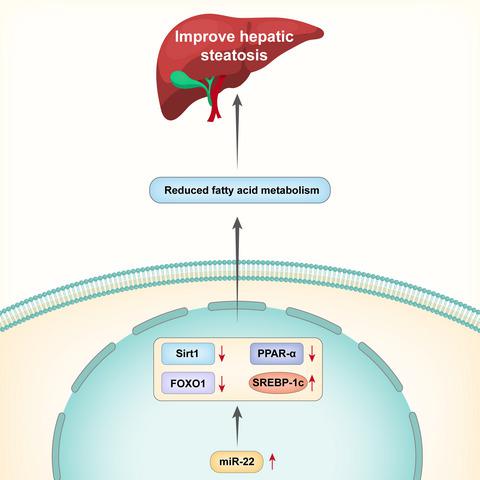当前位置:
X-MOL 学术
›
FEBS Open Bio
›
论文详情
Our official English website, www.x-mol.net, welcomes your
feedback! (Note: you will need to create a separate account there.)
MiR‐22 modulates the expression of lipogenesis‐related genes and promotes hepatic steatosis in vitro
FEBS Open Bio ( IF 2.8 ) Pub Date : 2020-11-06 , DOI: 10.1002/2211-5463.13026 Zhuo Yang 1 , Wen Qin 1 , Junsheng Huo 1 , Qin Zhuo 1 , Jingbo Wang 1 , Liyuan Wang 1
FEBS Open Bio ( IF 2.8 ) Pub Date : 2020-11-06 , DOI: 10.1002/2211-5463.13026 Zhuo Yang 1 , Wen Qin 1 , Junsheng Huo 1 , Qin Zhuo 1 , Jingbo Wang 1 , Liyuan Wang 1
Affiliation

|
Nonalcoholic fatty liver disease (NAFLD) is highly correlated with obesity, and lifestyle changes to reduce weight remain the main therapeutic approach. The noncoding RNA miR‐22 has previously been reported to be highly abundant in the sera of NAFLD patients. In addition, miR‐22 directly targets peroxisome proliferative‐activated receptor, Pgc‐1α, peroxisome proliferator‐activated receptor α, and sirtuin 1 (Sirt1), which are important factors involved in fatty acid metabolism. Given that miR‐22 directly targets genes involved in the control of metabolism and obesity, we investigated whether miR‐22 contributes to metabolic alterations induced by obesity. We observed increased expression of miR‐22, decreased expression of Sirt1, and alterations in the expression of adipogenesis‐related genes in a mouse model of obesity and a human hepatocyte cell line. We identified that miR‐22 and the 3′‐UTR of Sirt1 are complementary. Mutation of the complementary fragment abolishes the ability of miR‐22 to regulate the Sirt1 gene. Furthermore, treatment of hepatic steatosis cells with miR‐22 mimics or inhibitors showed that miR‐22 can promote hepatic steatosis, and miR‐22 inhibitors effectively reduced triglyceride levels without affecting cell activity. Finally, we validated that miR‐22 has similar effects on downstream lipid metabolism‐related genes. Our data reveal the pathways and mechanisms through which miR‐22 regulates lipid metabolism and suggest that miR‐22 inhibitors may have potential as candidate drugs for NAFLD and obesity.
中文翻译:

MiR-22 在体外调节脂肪生成相关基因的表达并促进肝脂肪变性
非酒精性脂肪肝(NAFLD)与肥胖高度相关,改变生活方式以减轻体重仍然是主要的治疗方法。先前已报道非编码 RNA miR-22 在 NAFLD 患者的血清中非常丰富。此外,miR-22直接靶向过氧化物酶体增殖激活受体Pgc-1α、过氧化物酶体增殖物激活受体α和sirtuin 1 (Sirt1),它们是参与脂肪酸代谢的重要因子。鉴于 miR-22 直接靶向参与控制代谢和肥胖的基因,我们研究了 miR-22 是否有助于肥胖引起的代谢改变。我们观察到 miR-22 的表达增加,Sirt1的表达减少,以及肥胖小鼠模型和人类肝细胞系中脂肪生成相关基因表达的改变。我们发现 miR-22 和Sirt1的 3'-UTR是互补的。互补片段的突变消除了 miR-22 调节Sirt1的能力基因。此外,用 miR-22 模拟物或抑制剂处理肝脂肪变性细胞表明 miR-22 可以促进肝脂肪变性,并且 miR-22 抑制剂有效降低甘油三酯水平而不影响细胞活性。最后,我们验证了 miR-22 对下游脂质代谢相关基因具有相似的作用。我们的数据揭示了 miR-22 调节脂质代谢的途径和机制,并表明 miR-22 抑制剂可能具有作为 NAFLD 和肥胖症的候选药物的潜力。
更新日期:2021-01-04
中文翻译:

MiR-22 在体外调节脂肪生成相关基因的表达并促进肝脂肪变性
非酒精性脂肪肝(NAFLD)与肥胖高度相关,改变生活方式以减轻体重仍然是主要的治疗方法。先前已报道非编码 RNA miR-22 在 NAFLD 患者的血清中非常丰富。此外,miR-22直接靶向过氧化物酶体增殖激活受体Pgc-1α、过氧化物酶体增殖物激活受体α和sirtuin 1 (Sirt1),它们是参与脂肪酸代谢的重要因子。鉴于 miR-22 直接靶向参与控制代谢和肥胖的基因,我们研究了 miR-22 是否有助于肥胖引起的代谢改变。我们观察到 miR-22 的表达增加,Sirt1的表达减少,以及肥胖小鼠模型和人类肝细胞系中脂肪生成相关基因表达的改变。我们发现 miR-22 和Sirt1的 3'-UTR是互补的。互补片段的突变消除了 miR-22 调节Sirt1的能力基因。此外,用 miR-22 模拟物或抑制剂处理肝脂肪变性细胞表明 miR-22 可以促进肝脂肪变性,并且 miR-22 抑制剂有效降低甘油三酯水平而不影响细胞活性。最后,我们验证了 miR-22 对下游脂质代谢相关基因具有相似的作用。我们的数据揭示了 miR-22 调节脂质代谢的途径和机制,并表明 miR-22 抑制剂可能具有作为 NAFLD 和肥胖症的候选药物的潜力。











































 京公网安备 11010802027423号
京公网安备 11010802027423号